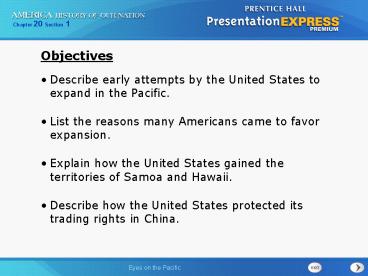AHON Chapter 20 Section 1 Lecture Notes - PowerPoint PPT Presentation
1 / 17
Title:
AHON Chapter 20 Section 1 Lecture Notes
Description:
... building empires by imposing political and economic control over peoples around the world Frederick Jackson Turner historian who argued that the western ... – PowerPoint PPT presentation
Number of Views:90
Avg rating:3.0/5.0
Title: AHON Chapter 20 Section 1 Lecture Notes
1
Objectives
- Describe early attempts by the United States to
expand in the Pacific. - List the reasons many Americans came to favor
expansion. - Explain how the United States gained the
territories of Samoa and Hawaii. - Describe how the United States protected its
trading rights in China.
2
Terms and People
- Matthew C. Perry Commodore of the Navy who led a
squadron of U.S. warships to Japan to open trade
with the nation - isolationism policy of avoiding involvement in
other countries affairs - imperialism building empires by imposing
political and economic control over peoples
around the world - Frederick Jackson Turner historian who argued
that the western frontier defined American history
3
Terms and People (Continued)
- Liliuokalani Queen of Hawaii who advocated for
Hawaiian independence - sphere of influence areas where another nation
has economic and political control
4
How did the United States acquire new territory
and expand trade in the Asia-Pacific region?
In the mid-1800s, the United States was ready to
take on new challenges.
Finding new trading partners
Acquiring new land
5
U.S. merchants longed to trade with Japan, which
had blocked outside trade for 250 years.
In 1853, Matthew C. Perry led U.S. warships into
Tokyo Bay.
The Japanese were awed by Perrys ships. In 1854,
Japan agreed to trade with the U.S.
6
In 1867, U.S. Secretary of State William Seward
arranged the purchase of Alaska from Russia.
- He hoped to open trade in Asia and the Pacific.
- Critics thought the land was worthless. They
called the deal Sewards Folly.
Alaska turned out to be rich in gold and other
resources.
7
Until the late 1800s, American foreign policy
differed from that of many European nations.
America The U.S. generally pursued a policy of
isolationism. It did not get involved in other
nations affairs.
European Nations Many nations undertook a policy
of imperialism. They wanted to expand into new
territories.
8
In the late 1800s, America was gripped by a new
spirit of expansionism.
Supporters made several arguments about the
benefits of expansionism.
9
Causes and Effects of U.S. Expansionism
10
U.S. expansionists expressed interest in many
Pacific Island chains, including Samoa.
Three nations fought for Samoa.
U.S.
Britain
In 1899, the U.S. and Germany divided Samoa.
Germany
The people of Samoa had no say in the matter.
11
Americans also eyed Hawaii, because its location
was ideal for a military outpost between the U.S.
and Asia.
12
In 1893, American planters organized an uprising
that ultimately led the U.S. to annex Hawaii.
A U.S. official sent 50 Marines to Hawaii.
The Marines overthrew the queen.
Hawaii became a U.S. territory in 1898.
President Cleveland declared the revolt illegal.
President McKinley signed a treaty to annex
Hawaii.
13
Expansion across the Pacific allowed the U.S. to
gain resources, open new markets, and encourage
trade.
14
In the late 1800s, China was weakened by war.
Other nations took advantage of this weakness.
U.S. Secretary of State wanted to keep an open
door in China. He wanted to preserve trade with
China.
15
In 1900, the U.S. helped end the Boxer Rebellion
in China.
- The Boxers opposed foreigners in China.
- They staged a violent rebellion in 1900.
The U.S. and other powers sent troops to end the
rebellion.
16
To prevent the other powers from seizing Chinese
territory, Secretary Hay issued a second Open
Door note.
America intended to preserve open trade with
other nations.
China should not be broken up into separate
pieces.
17
Section Review
Know It, Show It Quiz
QuickTake Quiz































